Do This for Spine Pain Relief in 4 Moves
Easy At-Home Exercises for Back Pain
This article provides information supporting some of the suggested exercises from a physical therapist once your sessions are completed.
Living with back issues like lumbar spinal stenosis requires daily adjustments to continue being functional. Although the main reason we make day-to-day changes is to relieve back pain, we sometimes end up making the situation worse. Consequently, following your healthcare provider’s recommendations is essential.
Spinal stenosis is when the spine’s spaces narrow, putting direct pressure on the lower back’s nerves. The neck (cervical spine)—furthermore, it is attributed to wear-and-tear spinal tissue and wear-and-tear related to osteoarthritis.
It is excruciating and, at times, physically debilitating. However, through an intense physical fitness regimen, I am on a quest to eliminate my pain and discomfort.
With a physical therapist’s aid, I have created a healthy regimen to accomplish this goal. I typically trained on my own five days a week and with a physical therapist once weekly.
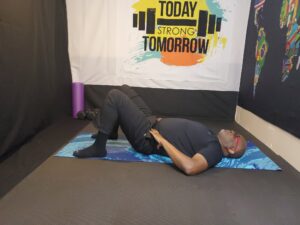
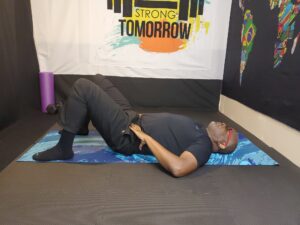
SUPINE SEGMENTAL BRIDGE targets the glutes, hamstrings, and spine extensors, which tend to be severely underworked muscles whenever we become sedentary.
Instructions:
- Lay on your back and bend both knees with feet flat on the floor and arms by your side.
- Inhale, then exhale, roll the pelvis under, and engage your abdominal muscles.
- While you exhale, keep your pelvis tucked under and roll one vertebra at a time to get your shoulders, hips, and knees in a straight line.
- Once in a straight line, inhale, exhale, and begin rolling back down, starting from your upper spine, one vertebra at a time.
- Perform these movements slowly.
Repeat: 10 Times
Complete 3 Sets Perform 1 Time a Day
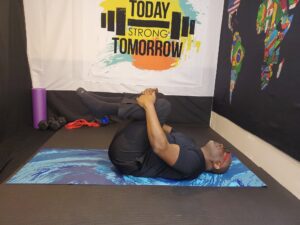
DOUBLE KNEE TO CHEST targets the core, lumbar spine, and hip muscles.
Instructions:
- Lay on your back and place both feet on a stability ball.
- Bend the knees (you may extend the legs if you have more control or no lower back discomfort).
- Engage your deep core muscles, breathe regularly, and roll the ball toward your chest.
- Feel the stretch in your lower back and return to the starting position.
Repeat: 10 Times Hold 1 second
Complete 3 Sets Perform 1 Time a Day
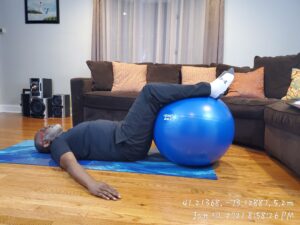
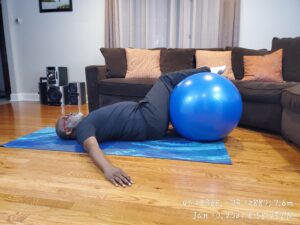
SUPINE TRUNK ROTATION (w/ exercise ball): improves stabilization and range of motion in the lumbar region muscles, including the latissimus dorsi, external and internal oblique, transversus abdominis, and multifidus.
Instructions:
- Place your back on the ball and bend your knees.
- Bend your knees 90 degrees, and raise your hips off the ball.
- Extend your arms in front of your chest with your palms together.
- Keep your lower body stable. Rotate your arms from side to side and slowly roll your shoulders. Go no further than 45 degrees on each side.
Repeat: 10 Times (each side) Hold 1 Second
Complete 3 Sets Perform 1 Time a Day

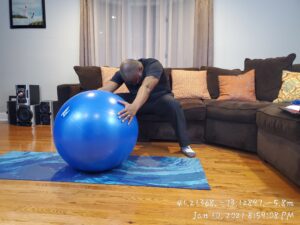
LOWER-BACK STRETCH (w/Swiss ball): targets the whole back, emphasizing the latissimus dorsi, and will provide a lumbar spine release.
Instructions:
- Begin in an upright position, seated on a chair or kneeling.
- Be sure to have your feet and knees straight forward, facing the ball.
- Roll forward on the ball with your weight evenly distributed on the surface and your hips facing forward.
- Hold the stretch for 30 seconds, then return to the seated or kneeling.
- Roll the ball left (or right) with your weight evenly distributed on its surface and your hips facing forward.
- Hold the stretch for 30 seconds, then return to the seated or kneeling.
- Now roll to the opposite side, hold for 30 seconds, and return to the seated or kneeling.
Perform 30 Times (10 each angle) Hold 30 Seconds
Complete 3 Sets Perform 1 Time a Day
Conclusion:
I continue to exhibit limited ranges of motion with all of the above exercises. The trunk rotations appear stunted and do not go far enough. The segmental bridge, roll down, and back stretch appear stiff with limited spinal coordination and elongation. The lack of range I have comes from painful pinching on the spinal cord, muscle tightness, and spasms. I perform stretches for my hamstrings, piriformis, hip flexors, abductors, IT Band, and quadriceps.
If you are dealing with lower back pain, seek a medical professional to get the treatment and fitness recommendations. The physical therapy exercises shared on this blog are for educational purposes.
Before starting any new health and fitness program or taking supplements, it’s crucial to consult with your healthcare professional. They can provide personalized advice based on your medical history and current health status, ensuring your new regimen is safe and effective. This step helps prevent potential health risks and ensures that any changes you make are beneficial and sustainable in the long run. Your healthcare professional is your best resource for making informed decisions about your health and wellness journey.



